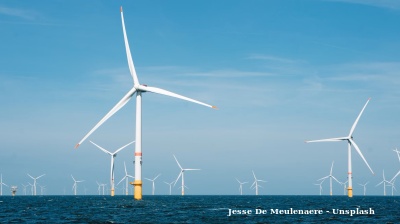A new study predicts the AMOC (Atlantic Meridional Overturning Circulation), a oceanic current that brings warm water to the northern Atlantic, could collapse as soon as 2025, ushering in a new ice age in northern Europe.
Previous studies have predicted the AMOC will collapse by 2100 with “95% certainty”, but have been vague about how soon that could happen.
The AMOC, also known as the Gulf Stream, brings warm water from the Equator to the northern hemisphere, but the large volumes of fresh water being dumped into the seas near the poles have slowed the current, which will eventually stop flowing, dramatically lowering the temperatures in the region. Winter temperatures in places like London and Paris could then fall by 10C-30C, creating Siberian winter-like conditions in Western Europe.
The AMOC has stopped flowing in the past, which was responsible for the last ice age in Europe, and once stopped, can take hundreds of thousands of years to restart. The collapse of the AMOC is one of the various irreversible “tipping points” of the Climate Crisis that scientists say could set off a cascade of environmental disasters.
The AMOC has already been slowing, but the Climate Crisis is accelerating faster than scientists predicted. As bne IntelliNews reported, six out of nine planetary boundaries have already been crossed in the last 20 years that scientists use as indicators of how close a global environmental crisis is, and the remaining three are close to exhausted.
The new study, published in Nature Communications, found the AMOC could collapse as early as 2025, leading to catastrophic climate impacts, but also said that the central assumption in the spread of possibilities was for a collapse in 2050 – still significantly sooner than previous estimates.
If the AMOC stops flowing not only will temperatures in Western Europe plunge in the winter, but global rainfall patterns will also be dramatically altered that will devastate ecosystems around the world as well as causing disastrous knock-on effects for agriculture that will affect global food supplies. Agriculture in India, South America and West Africa would be most affected by the changed rain patterns.
The system is already at its weakest level in the last 1,600 years, primarily due to global warming. In 2021, researchers detected early warning signs that the tipping point in the current’s flow is approaching.
The study, led by Prof Peter Ditlevsen from the University of Copenhagen, used sea surface temperature data dating back to 1870 to analyse changes in AMOC's strength over time. The data suggested that AMOC is approaching a critical tipping point known as a "saddle-node bifurcation."
"I think we should be very worried," Ditlevsen said. "This would be a very, very large change. The AMOC has not been shut off for 12,000 years."
Europe could experience increased storms and colder temperatures, while sea levels could rise along the eastern coast of North America as a result. Additionally, the collapse could further threaten the Amazon rainforest and Antarctic ice sheets. The Amazon was already suffering from a “mega drought” last year, but the end of the AMOC would dramatically change precipitation in South America and cause droughts where there was once rainforests.
The study's projections are based on the continuation of current greenhouse gas (GHG) emission trends. If emissions are curtailed in line with existing climate policies, the tipping point could be delayed, giving more time to prevent a collapse. However, as bne IntelliNews reported, humanity is currently burning through its carbon budget at an alarming rate, with the developed markets and the US and EU having already used up all their emission allotment. Many scientists say the 1.5C increase in temperature target set by the Paris Agreement in 2015 has already been missed and the world is on course for a 2.5C increase, which means the various tipping points would be crossed. In this scenario large parts of the planet would become uninhabitable within a century.
The Intergovernmental Panel on Climate Change (IPCC) previously assessed that AMOC would not collapse within this century. However, Ditlevsen noted that the IPCC models might underestimate the risk due to their coarse resolution and limited ability to account for non-linear processes. Indeed, scientists increasingly agree that the climate models are wrong and underestimate the rate the world is warming.
The timing of the collapse of AMOC remains a contentious issue among scientists, but all agree that a collapse must be avoided "at all costs" to prevent dire consequences for global climate systems.
bneGREEN

Singapore’s green pivot – headline grabbing but still limited
Forays into offshore wind via regional cooperation with neighbours, and forward-looking bets on hydrogen and low-carbon fuels are making headlines, but the scale required to wean a heavily gas-dependent system off fossil fuels is still daunting.

North Macedonia's Skopje tackles mounting waste and rodent crisis
Locals say the problems in Skopje's Centar municipality worsened during the local election period when political campaigning took precedence over maintenance.

Malaysia–Vietnam offshore wind project to deliver 2,000 MW by 2034, strengthening regional green energy links
Malaysia’s upcoming offshore wind project connecting Vietnam to Peninsular Malaysia is expected to generate up to 2,000 megawatts (MW) of clean energy by 2034, marking a major step in the nation’s renewable energy expansion

EBRD invests €16.8mn in Croatia’s first large-scale battery storage and virtual power plant
Development bank to take its first equity stake in a standalone merchant storage project.


.jpeg)
_1761305900.jpg)
_1761147529.jpeg)